The Industrial Archaeology and History of the Western Valley
Or click on the button to go to :-
Click on the thumbnail to enlarge a photo or map and sometimes read more about it.
Then click 'Full Size' on the toolbar to see it in all its glory.
Prince of Wales Colliery
Prince of Wales Colliery - ST 2140 9465
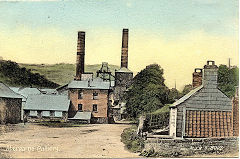
The Prince of Wales Colliery
|
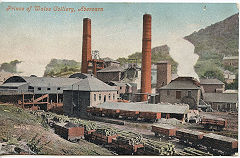
The Prince of Wales Colliery
|

The Prince of Wales Colliery
|
|
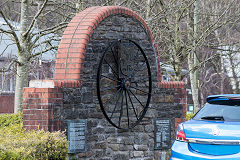
Monument to the Colliery disaster
|
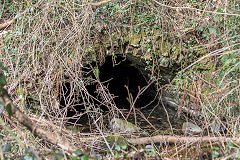
Colliery drainage level
|
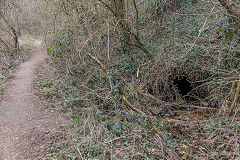
Colliery drainage level
|
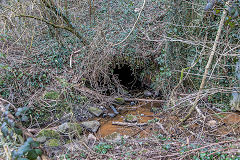
Colliery drainage level
|
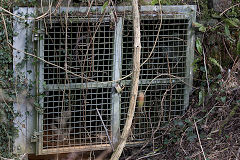
Colliery drainage level
|
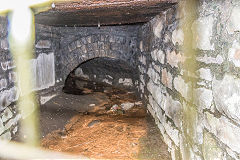
Colliery drainage level
|
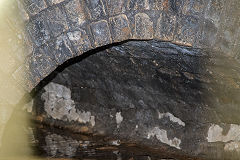
Colliery drainage level
|
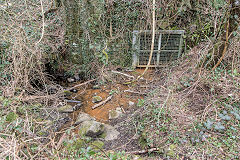
Colliery drainage level
|
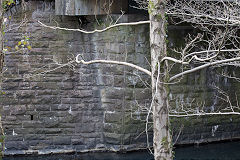
Colliery railway bridge
|
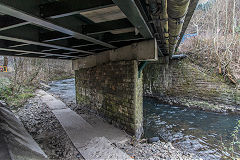
Colliery railway bridge
|
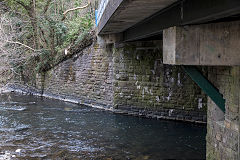
Colliery railway bridge
|

Colliery railway bridge
|
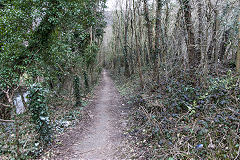
The Colliery sidings on right
|
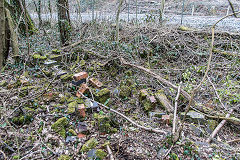
GWR signal box at junction
|
|
|
Abercarn Tinplate Works
Lower tinplate works - ST 2122 9501
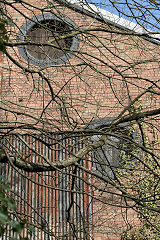
Lower tinplate works
|
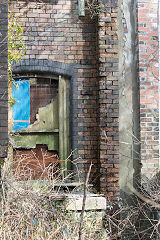
Lower tinplate works
|
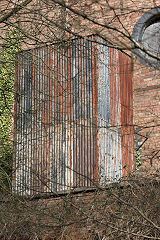
Lower tinplate works
|
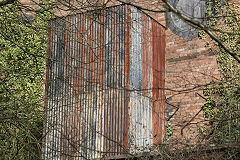
Lower tinplate works
|
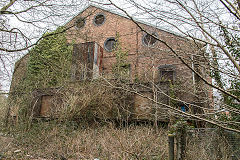
Lower tinplate works
|

Lower tinplate works
|
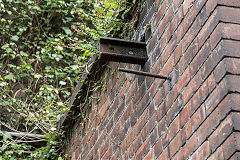
Lower tinplate works
|
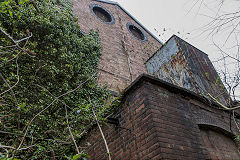
Lower tinplate works
|
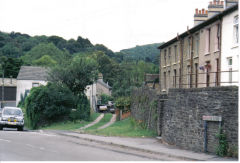
Railway to Upper works
|
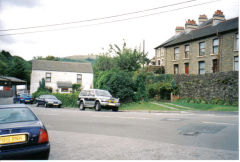
Railway to Upper works
|

Railway from Lower works
|
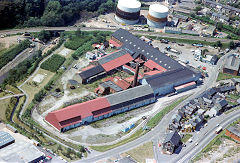
Lower tinplate works, 1976
|
Upper tinplate works - ST 2161 9528
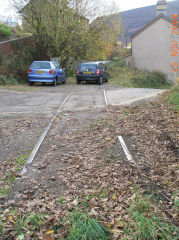
Railway to Lower works
|
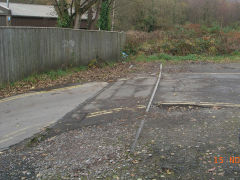
Railway from Lower works
|
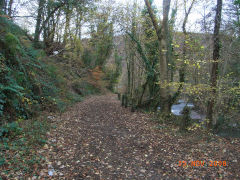
Railway to Lower works
|
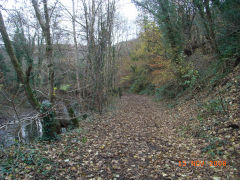
Railway from Lower works
|
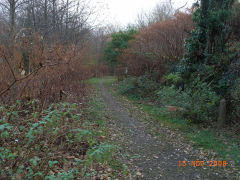
Railway from Lower works
|
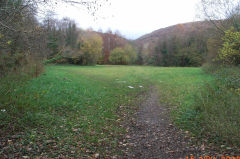
Upper tinplate works site
|
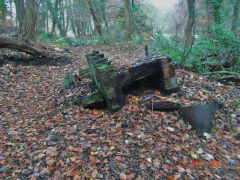
Upper tinplate works ruins
|
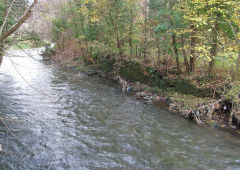
Stonework of Western riverbank
|
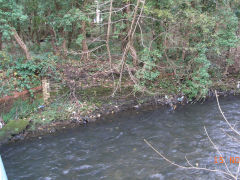
Stonework of Western riverbank
|
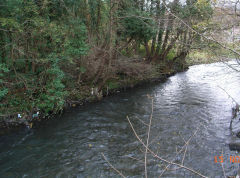
Stonework of Western riverbank
|
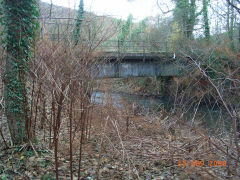
Railway bridge to GWR
|
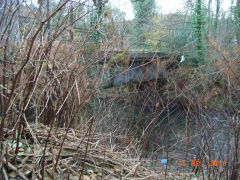
Railway bridge to GWR
|

Railway bridge to GWR
|
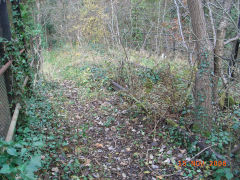
Railway bridge to GWR
|
|
|
Abercarn Village and the Furnace
The tunnel under High Street - ST 2156 9486
This tunnel under High Street appears to be quite old but it's purpose is obscure. It was probably access to Abercarn Furnace or an early tramroad from Quarry Pit to the canal by the bridge and lock. It also seems to have been used as a bomb shelter during WW2 according to post-war maps.
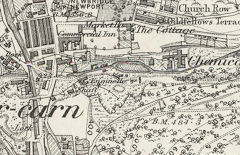
The Distillery Pond area, 1875
|
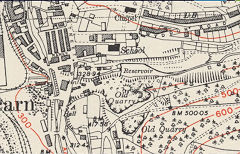
The Distillery Pond area, 1948
|
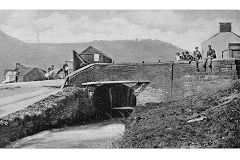
The bridge and lock over the canal
|
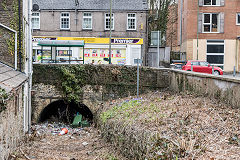
The tunnel under High Street
|
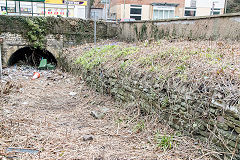
The tunnel under High Street
|

The tunnel under High Street
|
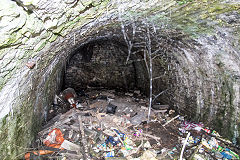
The tunnel under High Street
|

The tunnel under High Street
|
Abercarn Furnace - ST 2162 9487
This is the site of the second charcoal iron-smelting blast furnace of 1753 which ceased work in c1788. Two furnace arches are visible, together with the charging house. The site of the dam and pool that powered the bellows for draught can be seen beyond the distillery pond. The furnace is the earliest fairly intact surviving iron furnace in the south Wales coalfield. The first iron furnace was at Graig Furnace higher up the Gwyddon Valley and later ironworks were nearer the site of the lower tinplate works.
The print of the works in the 1770s is available from
Risca Industrial History Museum

Abercarn Furnace from 1750s
|

Abercarn Furnace in 1754
|
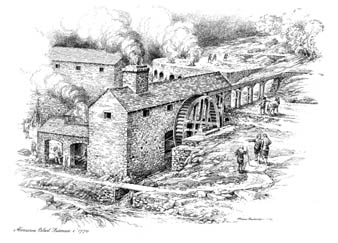
Abercarn Furnace, 1770s
|

The front of the charging house
|
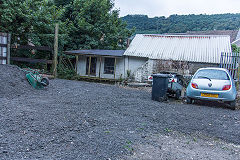
The side of the charging house
|

The waterwheel pit
|
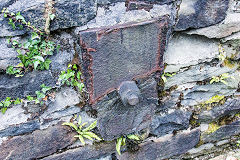
Detail on the charging house
|
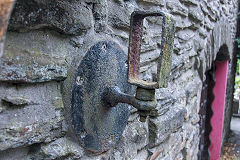
Detail on the charging house
|
The chemical works and distillery pond - ST 2180 9485
Abercarn Brewery - ST 2220 9500
The chemical works (distillery) produced an acid for use in the wool-dying industry. It was owned by David Morris & Son, who also owned the chemical works at Risca and Ynysddu. He went bankrupt in 1883 and it had certainly closed down by 1899, the distillery pond becoming a reservoir for the iron and tinplate works. It is also famous for its midnight Viking funeral ceremonies, loved-one's ashes put in a little matchstick boat, set alight and launched across the pond, a midnight dip, anyone? . Abercarn Brewery was a little further upstream but it too had closed by 1899 to become a mineral water factory until the 1940s.

The site of the chemical works
|
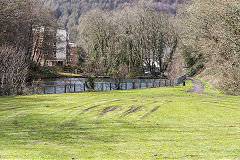
The site of the chemical works
|
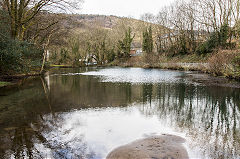
The Distillery Pond
|
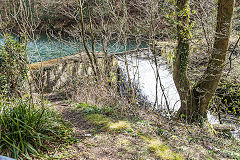
The Distillery Pond dam
|
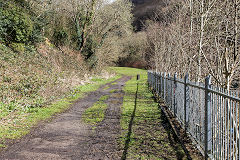
Tramway to the chemical works
|
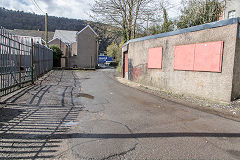
Tramway from the chemical works
|
|
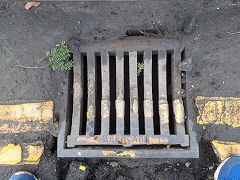
'M Morgan Abercarn'
|
Hafod Quarry, High Meadow - ST 2260 9655
A large modern quarry which developed after 1948 on the site of an older small quarry.
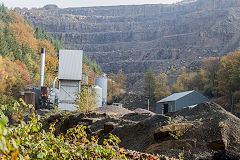
Hafod Quarry
|

Hafod Quarry
|
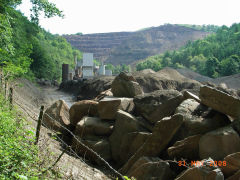
Hafod Quarry
|
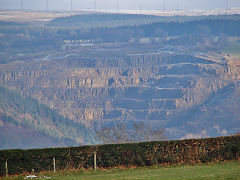
Hafod Quarry
|
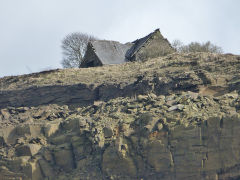
Hafod Fach barn above the quarry
|
|
West End
West End Village
A small, almost self-contained community on the West bank of the river, once the home of the gasworks, fire station and a foundry. There was also a railway line through the houses connecting the GWR with Halls Road Tramroad. At some time in Abercarn were 'Lloyds Engineering &and Foundry Co Ltd' c1895, 'Abercarn Engineering &and Foundry Co Ltd' and 'M Morgan' but where their foundry was sited is not clear. I suspect it was the foundry in West End linked to Halls Road. The was a Mrs Mary Morgan, wife of Richard Morgan, who ran the local ironmongers in Llanover Street but that seems a rather tenuous link to a foundry.
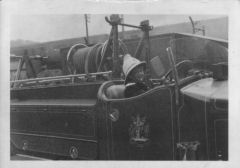
Abercarn Fire Station, 1953
|
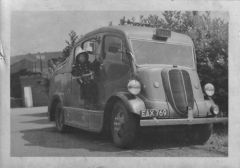
Abercarn Fire Station, 1953
|
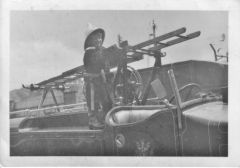
Abercarn Fire Station, 1953
|
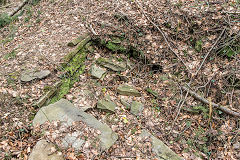
Foundations in the woods
|

Foundations in the woods
|
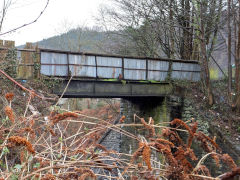
GWR footbridge
|
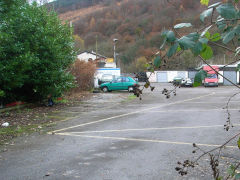
Site of gasworks and fire station
|
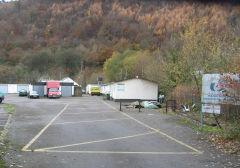
Site of gasworks and fire station
|
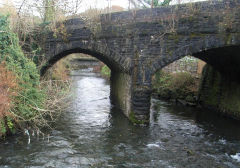
GWR and tinplate works bridges
|
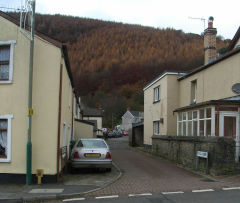
Railway to Halls Road Tramroad
|
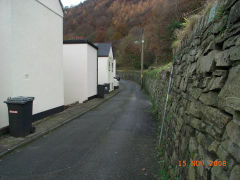
Railway to Halls Road Tramroad
|
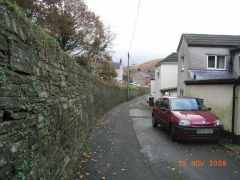
Railway to Halls Road Tramroad
|
Pant-y-Resk level crossing - ST 2139 9546
There was a level crossing where Halls Road crossed Pant-y-Resk Road. The historical view shows both the railway and the route of the original tramroad. Recently the trackbed, overgrown for years, has had the immediate surroundings cleared and fenced in 2021 for no apparent reason, some grand plan? or just money left in a kitty that needed spending?
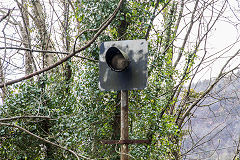
Level crossing warning signal
|
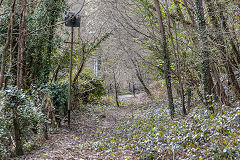
Level crossing warning signal
|
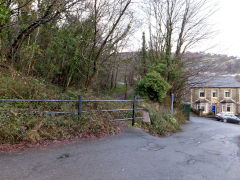
Halls Road level crossing North
|
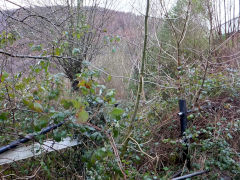
Halls Road level crossing South
|
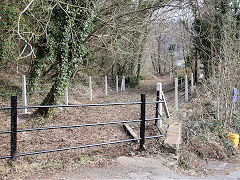
Halls Road level crossing
|

Halls Road level crossing
|
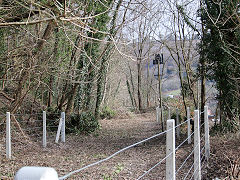
Halls Road level crossing
|
|
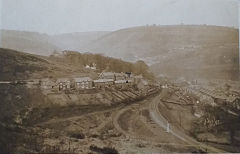
Halls Road railway and tramroad
|
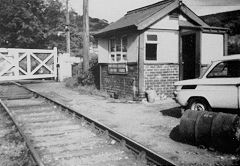
Halls Road level crossing
|

Halls Road level crossing
|
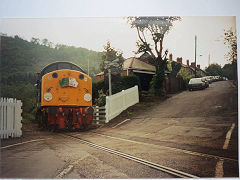
Halls Road level crossing
|
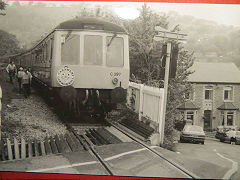
Halls Road level crossing
|
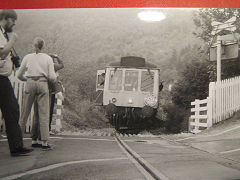
Halls Road level crossing
|
|
|
Abercarn and Newbridge Gas and Water Co Ltd
Gas was first supplied from Abercarn Gasworks on 17 November 1876. The company appears to have been promoted by the Abercarn Colliery and the Tinplate Works. The contractor was Charles Jordan of Newport and the laying of the mains was contracted to Jesse Bailey of the Abercarn Colliery. Jesse Bailey also seems to have been active in procuring lamp posts for the company. The original gasworks was between the river and Halls Road and was replaced c1947 by a new one next to West End fire station on the other bank of the river.
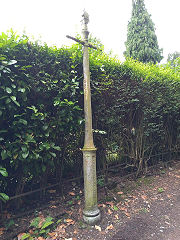
'Jesse Bailey Abercarn' lamp post
|
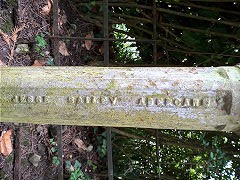
'Jesse Bailey Abercarn' lamp post
|
|
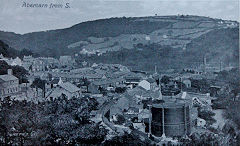
The original Abercarn Gasworks
|
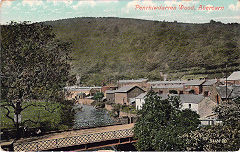
The original Abercarn Gasworks
|
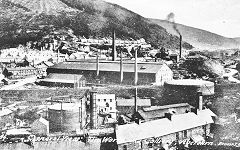
The original and the newer Gasworks
|
Cwm Pennar - ST 2080 9550
Steve Davies and I found a level, some pits or collapses and a possible ventilation shaft in the Cwm Pennar valley. They don't seem to appear on any maps but they could be connected with the workings of Pant-y-Rest Colliery at the head of the valley.
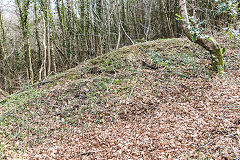
Cwm Pennar level
|
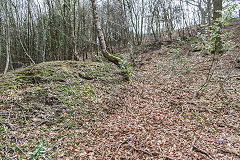
Cwm Pennar level
|

Cwm Pennar level
|

Cwm Pennar pits or collapses
|
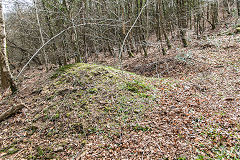
Cwm Pennar pits or collapses
|

Cwm Pennar pits or collapses
|
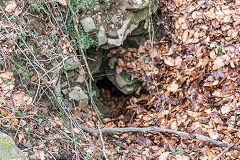
Cwm Pennar pits or collapses
|
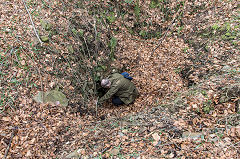
Cwm Pennar pits or collapses
|
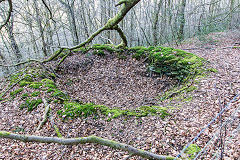
Cwm Pennar ventilation shaft
|
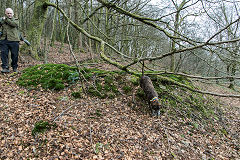
Cwm Pennar ventilation shaft
|
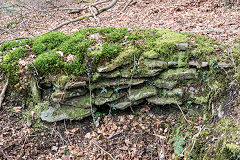
Cwm Pennar ventilation shaft
|

Cwm Pennar ventilation shaft
|
Celynen South Colliery
Celynen South Colliery - ST 215959
Celynen South Colliery, originally just Celynen or Celynon Colliery was opened by the 'Newport Abercarn Black Vein Steam Coal Co' in 1876 with 3 shafts. In the 1920s it became part of the 'Ebbw Vale Steel, Iron and Coal Co' and about 10 years later passed to 'John Paton and Partridge Jones'. The colliery closed in 1985 and the site is now a housing estate however an interesting relic of the aerial ropeway still exists.
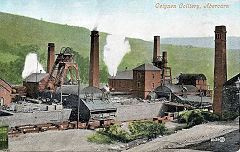
Celynen South Colliery
|
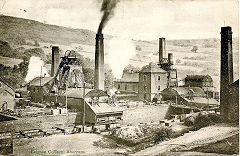
Celynen South Colliery
|

Celynen South Colliery
|
|
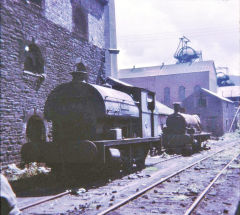
'Menelaus', Celynen South Colliery
|
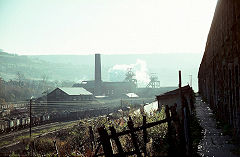
Celynen South Colliery, 1969
|
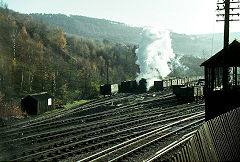
'47' at Celynen South Colliery
|
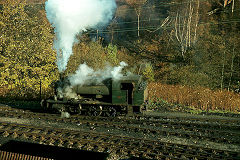
'47' at Celynen South Colliery
|
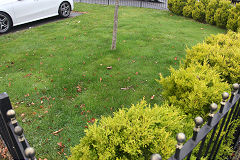
Celynen South Colliery shaft
|
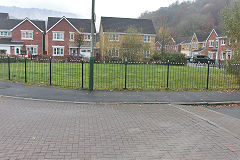
Celynen South Colliery shafts
|
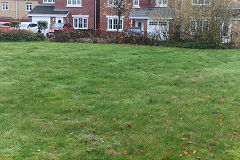
Celynen South Colliery shafts
|
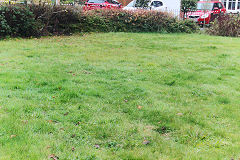
Celynen South Colliery shafts
|
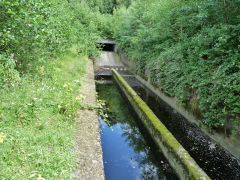
Celynen South tip sluice to river
|
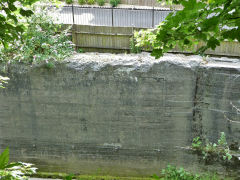
Celynen South tramway bridge
|
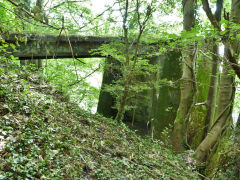
Celynen South tramway bridge
|
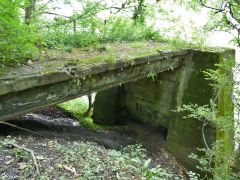
Celynen South tramway bridge
|
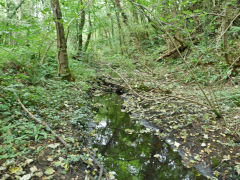
Monmouthshire Canal
|
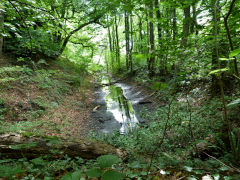
Monmouthshire Canal
|
|
|
Celynen South Colliery Aerial Ropeway - ST 2220 9680
The ropeway ran from the colliery to the now-landscaped tips on the top of Twyn-y-Gnol
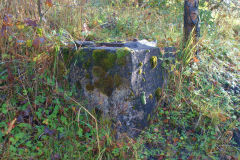
Aerial ropeway pylon foundations
|
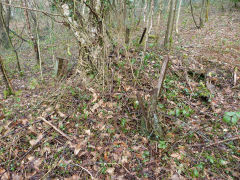
Aerial ropeway pylon foundations
|
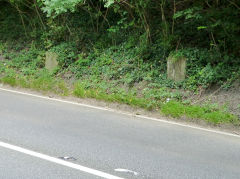
Aerial ropeway pylon foundations
|
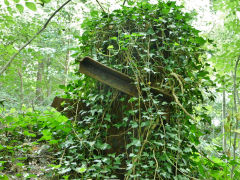
Aerial ropeway ironmongery
|
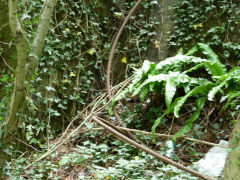
Aerial ropeway ironmongery
|

Aerial ropeway ironmongery
|
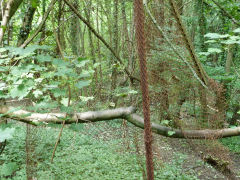
Aerial ropeway ironmongery
|
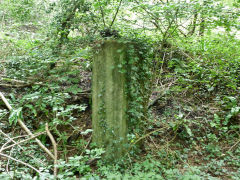
Aerial ropeway ironmongery
|
Bucket No 33
At some time it appears bucket No. 33 fell off the ropeway, spilling its contents and ending up in the undergrowth near the top of the ropeway. My partner, Jill, told about it in 2009 and took me up to see it. By 2013 it had been rolled or dragged down the hill and left upside down. Revisiting in 2023, it was back the right way up. Let's hope it's left alone now.
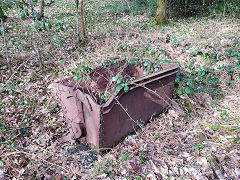
Bucket No 33 turned back up, 2023
|
|
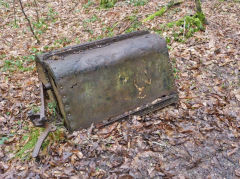
Bucket No 33 upside down, 2013
|
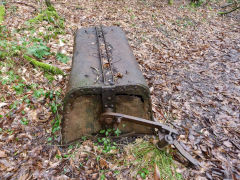
Bucket No 33 upside down, 2013
|
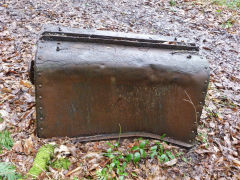
Bucket No 33 upside down, 2013
|

Bucket No 33 upside down, 2013
|
|

Bucket No 33, 2009
|
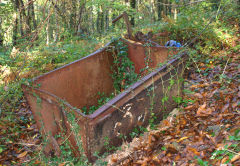
Bucket No 33, 2009
|
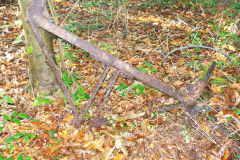
Bucket No 33, 2009
|
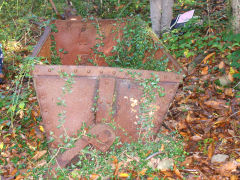
Bucket No 33, 2009
|
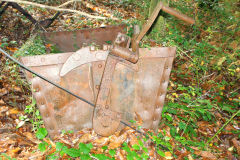
Bucket No 33, 2009
|
Celynen South Colliery Quarry - ST 2147 9573
The quarry was probably opened before the colliery to obtain the building stone for the colliery buildings. A tramway ran down to the colliery, passing under Halls Road Tramroad through a short tunnel. The tunnel is still there but for some reason only one end has been walled up (on the quarry side).
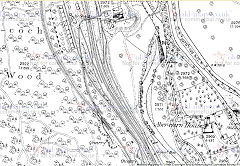
Celynen South Colliery Quarry, 1880
|
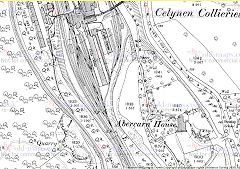
Celynen South Colliery Quarry, 1901
|
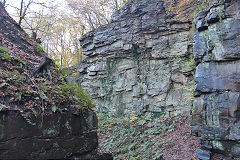
Celynen South Colliery Quarry
|
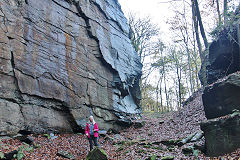
Celynon South Colliery Quarry
|
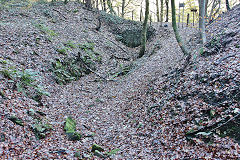
Celynen South Colliery Quarry
|
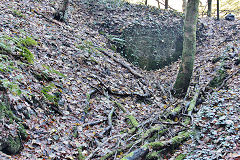
Celynon South Colliery Quarry
|
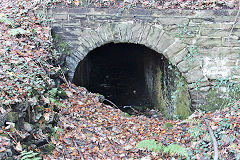
Celynen South Colliery Quarry
|
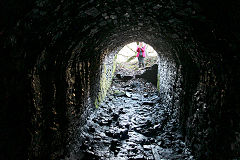
Celynen South Colliery Quarry
|
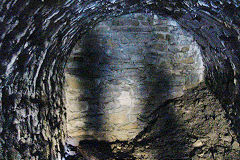
Celynen South Colliery Quarry
|

Colliery quarry tramway
|

Colliery quarry tramway
|
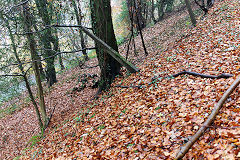
Colliery quarry tramway
|
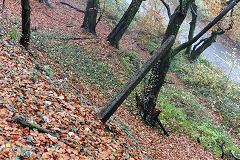
Colliery quarry tramway
|
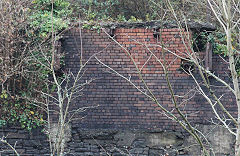
Colliery quarry tramway bridge
|
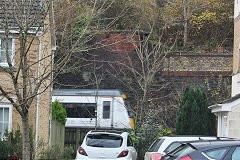
Colliery quarry tramway bridge
|
|
The Gwyddon Valley
Gwyddon Trial Level - ST 2255 9410
A rifle range existed periodically on the South side of the valley and, where the targets were, a square-cut stone tunnel leads about 300ft into the hillside. It was dug in the 1880s and there is a very minimal tip, the stone must have been used elsewhere, and it would seem no coal was found. There are odd 'scratchings' along the old rifle range that appear to have been attempts to find a coal seam.
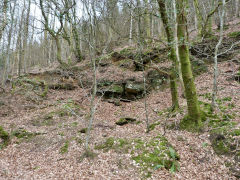
The Gwyddon trial level, 2012
|
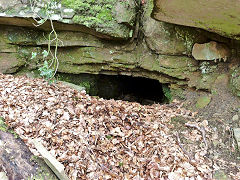
The Gwyddon trial level, 2012
|
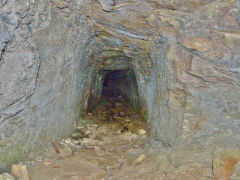
The Gwyddon trial level, 2012
|
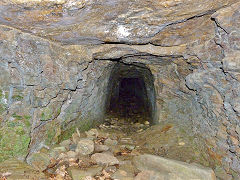
The Gwyddon trial level, 2012
|
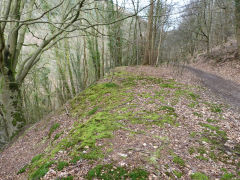
The Gwyddon trial level tip, 2012
|
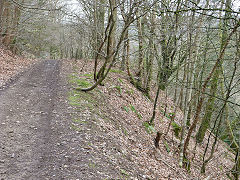
The Gwyddon trial level tip, 2012
|
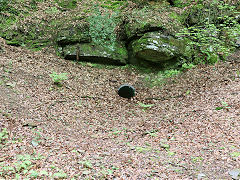
The Gwyddon trial level, 2023
|

The Gwyddon trial level, 2023
|
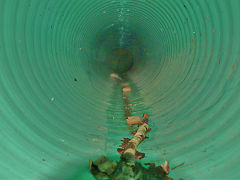
The Gwyddon trial level, 2023
|
|
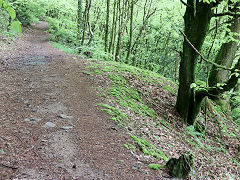
Other Gwyddon trial levels, 2023
|
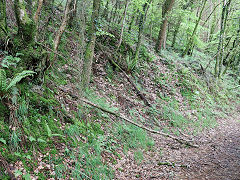
Other Gwyddon trial levels, 2023
|
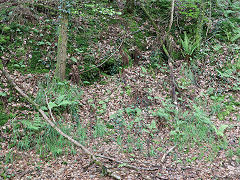
Other Gwyddon trial levels, 2023
|
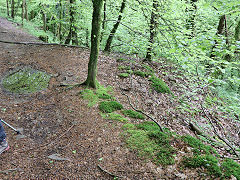
Other Gwyddon trial levels, 2023
|

Other Gwyddon trial levels, 2023
|
|
The Lost Farmsteads of the Nant Gwyddon Valley
A beautiful Autumn day and the Ramblers and the Twmbarlwm Society combine their forces for a full-frontal assault on the hidden depths of the Gwyddon Valley.
Sawmills - ST 2372 9577
Brook Bungalow - ST 2374 9594
When the Gwyddon was forested, probably in the 1940s and '50s, a sawmill was set up here in wooden and corrugated iron sheds. It's now just an open space.
First port-of-call is the site of Brook Bungalow, just above the site of the sawmill, and another tale of the macabre, the last elderly occupant hadn't been seen for a few days so when the police called in to check....
Craig Furnace - ST 2374 9594
A little further and we come across some mysterious stone walls, could be charcoal burners, could be aliens. Quickly followed by an equally mysterious hole-in-the-wall, didn't go back very far but what was it for? answers on a postcard to Rob Southall, please..
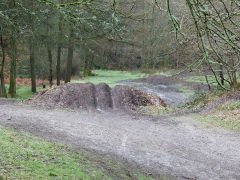
The site of Gwyddon sawmill
|
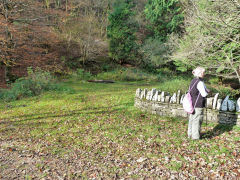
Site of Brook Bungalow
|
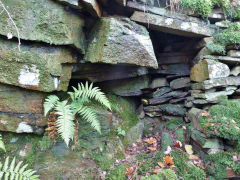
Stone buildings at Craig Furnace
|
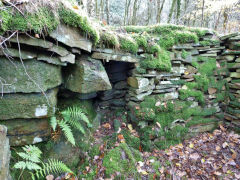
Stone buildings at Craig Furnace
|
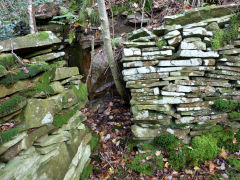
Stone buildings at Craig Furnace
|
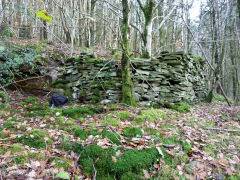
Stone buildings at Craig Furnace
|

Stone buildings at Craig Furnace
|
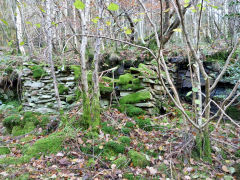
Stone buildings at Craig Furnace
|

Stone buildings at Craig Furnace
|
|
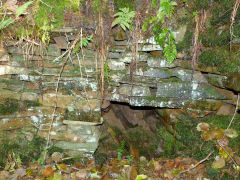
Hole at Craig y Trwyn
|
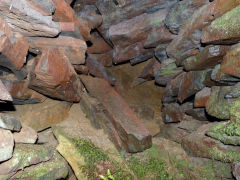
Hole at Craig y Trwyn
|
Trywyn - ST 2386 9647
Trywyn is next after a fair bit of uphill scrambling, just ruins but Rob had some great photos of a very attractive house.

Trwyn farmhouse
|
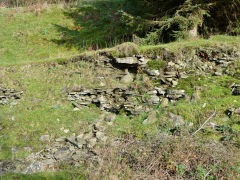
Trwyn farmhouse
|
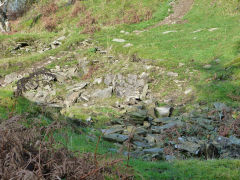
Trwyn farmhouse
|
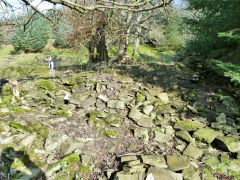
Trwyn farmhouse
|
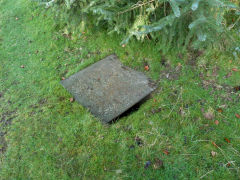
Trwyn farmhouse
|
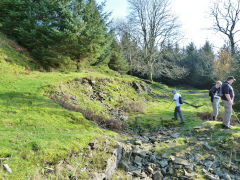
Trwyn farmhouse
|

Trwyn farmhouse
|

Trwyn farmhouse
|
Ysgubor Wen - ST 2440 9759
As we reach the moors we pass the scant foundations of Ysgubor Wen, believed to be quite ancient, then past a well-inscribed boundary stone, lunch, and down to Hafod Owen.
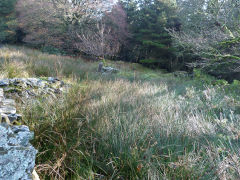
Ysgubor Wen
|
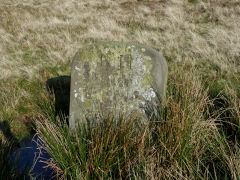
Boundary stone at Ysgubor Wen
|

Boundary stone at Ysgubor Wen
|
|
Hafod Owen - ST 2465 9690
A few outhouses, a pigsty and stable possibly, and a waterpipe remain, sad testimony to it's former occupants. Then the long trek down the valley and home.
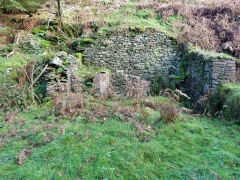
Hafod Owen Farmstead
|
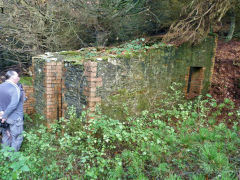
Hafod Owen Farmstead
|
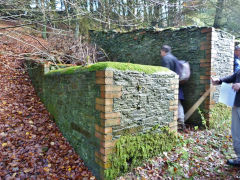
Hafod Owen Farmstead
|
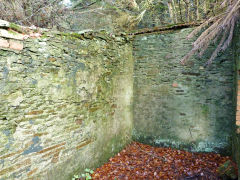
Hafod Owen Farmstead
|
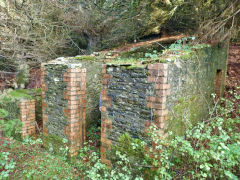
Hafod Owen Farmstead
|
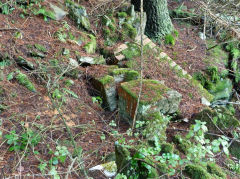
Hafod Owen Farmstead
|
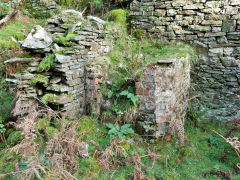
Hafod Owen Farmstead
|

Hafod Owen Farmstead
|
Foresters shelter or hut - ST 2342 9603
A small primitive building in the Gwyddon Valley appears to be a hut or shelter for a forester, charcoal-burner or shepherd, it's about 9ft square, built lean-to fashion against a small rock face with the other 3 walls made of stone. There's a central slab which may have been for a brazier or firebox and a narrow entrance. Certainly old, possibly early 19th century. many thanks to John Cottle for finding it. I was hoping it may have been an iron or lead level as there's no coal at all in the Gwyddon, which may just be a blessing !!

Foresters shelter or hut
|
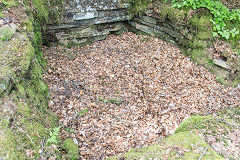
Foresters shelter or hut
|
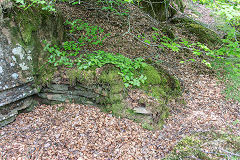
Foresters shelter or hut
|
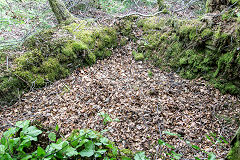
Foresters shelter or hut
|
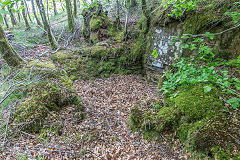
Foresters shelter or hut
|
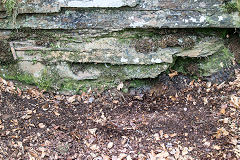
Foresters shelter or hut
|
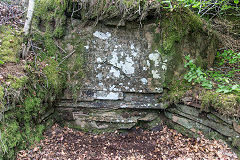
Foresters shelter or hut
|
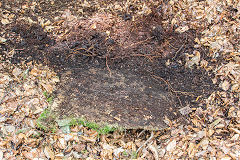
Foresters shelter or hut
|
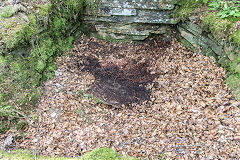
Foresters shelter or hut
|
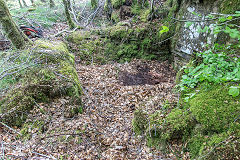
Foresters shelter or hut
|
|
|
Acknowledgments, sources and further reading.
Thanks to :- Lin Bryant, John Cottle, Steve Davies, Andrew Gadd, Alan Murray-Rust, Andrew Smith, Rob Southall, Richard Terrell, David Williams, OHIHS
'A historical tour around Mynyddislwyn Mountain' by Len Burland, Old Bakehouse Publications.
'Halls Tramroad' by Foster Frowin - A comprehensive five-part article appeared in 'Archive' magazine, Issues nos 55, 56, 59, 60 and 66 with loads of original photos and the 1840s tithe maps. Fascinating reading!!
A history of the Abercarn Ironworks by F. Frowen, L. Milsom and L. Burland, Gwent Local History Journal, Spring 1997, vol.82, p.16.
A Guide to the Website
Industrial Wales
Collieries, Ironworks, Quarries, Railways, Canals, Tramroads, Tunnels, Culverts and so much more....
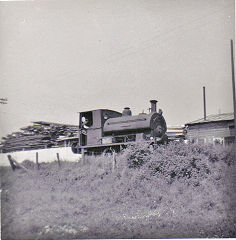
|
Brickworks of Wales
Bricks are 'History with a label' so here's the story of the Brickworks of Wales - photos, maps and the products themselves
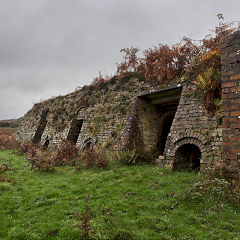
|
Around the World
My travels around the UK and the Whole Wide World in search of industries, railways, trams and mines to name a few.
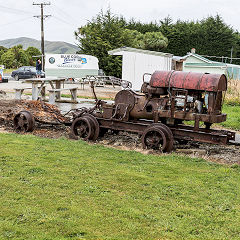
|
Boundary Stones and Mileposts
Boundary Stones, Mileposts and other markers in simple alphabetical order of their initials, name or site.

|
Ships and Shipping
Ships around the World in simple alphabetical order of their name (or apparent area if I can't read the name).

|
The Site Map and Index
A full list of all the pages of the whole website in just one place, so you should find exactly what you are looking for.

|
About the Site
The background and technical details about the site, plus a contact page and links to other sites - and a warning !!
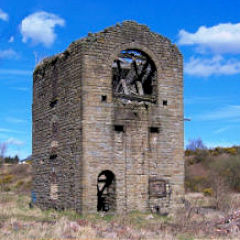
|
Contact Me
Something to add? A great photo? Something wrong? or need to know more about things? Just drop me a line here.

|
Further Reading
You can find lots of local and other very helpful websites, books, magazines and Facebook groups all listed here.
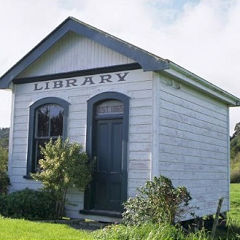
|
All rights reserved - Phil Jenkins





































